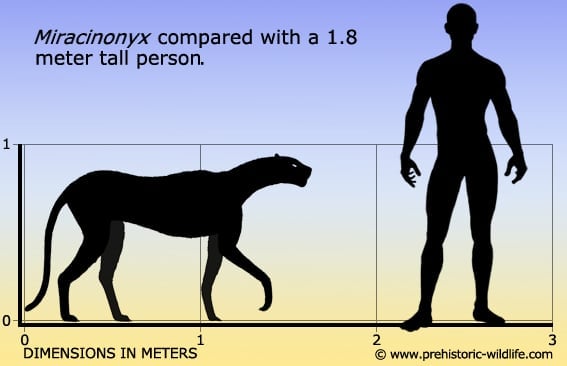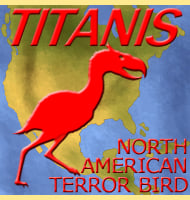Miracinonyx (original) (raw)
Miracinonyx
(American Cheetah)

Name:_Miracinonyx_(Amazing cheetah).
Phonetic: Mih-rah-sin-oh-nix.
Named By: Adams - 1979.
Synonyms: Possibly Miracinonyx studeri.
Classification: Chordata, Mammalia, Carnivora, Felidae.
Species: M. inexpectatus, M. trumani.
Diet: Carnivore.
Size: Roughly 85 centimetres high at the shoulder.
Known locations: North America.
Time period: Throughout the Pleistocene.
Fossil representation: Many specimens are known, although usually of fragmentary remains.
Often more popularly known as the American cheetah, _Miracinonyx_is actually thought to have been descended from cougar-like ancestors. It could be that the striking similarity between _Miracinonyx_and the African cheetah (_Acinonyx jubatus_) is actually a case of convergent evolution. This is where two animals from separate lineages end up looking the same because they make the same adaptations to cope with the same environment and lifestyle. However despite being thought to be evolved from cougar-like ancestors, Miracinonyx_is also regarded as being more closely related to the Puma. The exact origin for_Miracinonyx is also uncertain with theories being offered to explain both an Old and New World (Americas) origin for the genus.
Miracinonyx_like with many other prehistoric animals including Smilodon, displays species that are quite morphologically different to one another._Miracinonyx inexpectatus was built more like a cougar, although its overall build was considerably more gracile. This means that M. inexpectatus was much faster while still retaining some of the strength of a cougar. The result is that _M. inexpectatus_was the stronger species, and combined with its fully retractable claws was probably better at climbing.
Miracinonyx_trumani had an even lighter build than M. inexpectatus, meaning that it was the most similar to the modern cheetah. The claws on M. trumani however were only partly retractable. By being only partly retractable the claws could be used to gain more traction on the ground while running. This combined with the more gracile build meant that M. trumani was easily the faster of the two species. A third species,_M. studeri, is sometimes mentioned, however similarities between this species and M. trumani has led many people to treat _M. studeri_as a synonym to the latter.
Both species of Miracinonyx display specialist features for a high rate of respiration. These include short faces, with enlarged nasal cavities that would allow for a much greater volume of air being breathed in while running. This would reduce the amount of anaerobic respiration in the muscles which in turn would reduce the build-up of lactic acid meaning that Miracinonyx could run faster for longer as it pursued prey. When you do a large amount of exercise but have to stop because your muscles are tired it is because of a build-up of lactic acid caused by your muscles not being oxygenated fast enough.
Despite these adaptations for speed, Miracinonyx probably could not maintain these speeds indefinitely, and was probably more like a sprinter than a marathon runner with bursts of high speeds over short distances.Miracinonyx would still have had to rely upon stealth and cunning to approach a target, downwind to avoid its scent being detected and low down amongst long grass to avoid being seen. Only when it was sure it was close enough to its target would Miracinonyx_launch an attack, and if observation of big cats in Africa today is anything to go by, even then it might not always have been successful.
Because_Miracinonyx sacrificed strength for speed it could not hunt the larger American megafauna and so had to focus its attention upon smaller and swifter prey. The development of _Miracinonyx_towards speed may have been to fill an ecological niche as many of the other American predators such as _Smilodon_and the dire wolf were powerfully built predators adapted for tackling powerful but slower prey. The prey animal that is most often associated with _Miracinonyx_is the pronghorn, an animal very similar to antelope that has been often dubbed the second fastest land animal on Earth with speeds estimated at up to 80km/h (50mp/h). Again this draws another convergent similarity between Miracinonyx and the cheetah which hunts fast animals like gazelle.
Further reading
- The Cheetah: Native American. - Science 14 September 1979: Vol. 205 no. 4411 pp. 1155-1158. - Daniel B. Adams - 1979.
- The Plio-Pleistocene cheetah-like cat Miracinonyx inexpectatus of North America - Journal of Vertebrate Paleontology 10(4):434-454. - Blaire Van Valkenburgh, Frederick Grady & Bj�rn Kurt�n - 1990.
-Evolution of the extinct Sabretooths and the American cheetah-like cat. - Current Biology 15 (15): R589–R590 - Ross Barnett, Ian Barnes, Matthew J. Phillips, Larry D. Martin, C. Richard Harington, Jennifer A. Leonard, Alan Cooper - 2005.
----------------------------------------------------------------------------
Random favourites
 |
 |
 |
 |
|---|